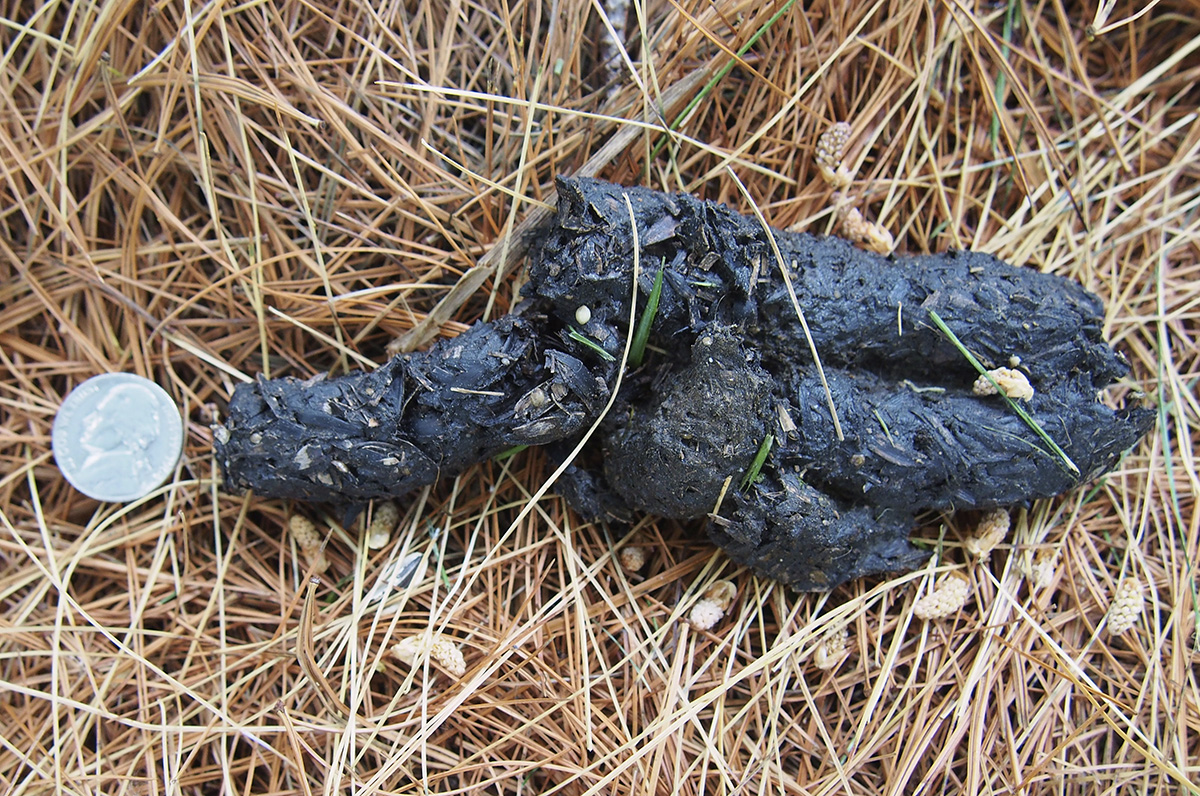
By Soni Cochran, Extension Associate
Whether you are tracking an animal while out hiking with your family or trying to figure out what type of animal is visiting your backyard, make sure you consider more than footprints. Take note of any other signs left behind by the animal. Look for scat, tail marks, claw marks and burrows/tunnels/trails through the yard. Sometimes these are the only clues we have of the wildlife we might encounter.
Scat (animal excrement, feces, “poop”) can tell us a lot of information about an animal. You can figure out the type of animal by the size, shape and consistency of the scat. Scat tells us where an animal has been and what it has been eating. Animals deposit scat where they rest or pause where they feel safe, so that tells us we may be able to find the animal there again. They may also deposit scat to mark their territory. Scat can also be a sign of an animal’s health.
I love to go hiking and when I’m out on a trail, I look for the presence of scat. Scat can tell me what animals live in the area and if they are near the trail. If I see moist scat left by a bison or a bear, I know to avoid going further and step up my situational awareness. I also use scat clues to decide what animal might be causing damage to plants in my garden or in the case of bats, where they might be hanging out under a porch.
Observe scat from a distance. Always consider your own safety when near scat. Avoid handling any droppings without proper personal protection. Avoid inhaling around scat. Some diseases may be contracted through dust-borne particles, so stay upwind if outdoors.
If you decide to examine scat, avoid handling it with your hands. When picking apart scat or pellets use a stick or disposable gloves. When you break apart the scat, take note of hulls of seeds, skins of berries and bits of leaves. This suggests the animal is an herbivore. Small bones, fur and feathers appear in the scat of carnivores. Insect wings and other insect body parts tells you the animal feeds on insects. Some animals — like coyotes — will eat both plants and animals, so you may find scat with the fur from rabbits and the seeds of mulberry fruit.
You’ll need to be a detective to try to identify what animal left the scat. Observe:
• Size, width and form. Is the scat round like a pellet? Tubular? Are both ends of the scat flat or pointed? Is one end pointed and the other flat? Is the scat smooth or is it segmented like a natural fibered rope?
• What do you see in the scat? Look for clues of what the animal has eaten.
• Scat tends to dry from the outside in. If the scat is completely dry, you know the animal passed by some time ago. Moist scat was left recently and the animal may be near.
• How many droppings are there? Single droppings in a line or multiple droppings in a pile?
• Do the droppings appear in the same general area over several days?
• Are the droppings left at night or during the day?
CAUTION: RACCON ROUNDWORMS
Raccoon roundworms (Baylisascaris procyonis) live in the intestines of raccoons. The roundworm lays upwards of 100,000 eggs each day which are shed through the raccoon’s feces (scat). Because raccoon roundworm poses danger to human health, it is important to protect yourself, family and pets from exposure to raccoons and their scat.
If you accidentally come into contact with raccoon scat, keep your hands away from your face. Wash skin with plain soap and warm water. Pay special attention to the area under the fingernails, use a brush. Wash clothes separately in hot, soapy water. Bleach and other disinfectants do not kill roundworm eggs. Wash any equipment you used to clean up raccoon scat with hot soapy water.
SCAT SAMPLES
If you bring scat to the Extension office for help with identifying an animal, keep safety in mind when collecting the scat and bringing it in. Your sample should be placed in a sealed clear plastic bag or clear container with a seal-tight lid. You will be asked to fill out a form with details such as where you found the scat. Office is located at 444 Cherrycreek Road, Ste. A, Lincoln. Hours are Monday–Friday, 8 a.m.–4:30 p.m.
FOR MORE INFORMATION
If you are interested in learning more about wildlife tracks and signs, there are a number of excellent field guides on the subject. Nebraska Extension in Lancaster County has many resources on pest animals online at http://lancaster.unl.edu/pest.